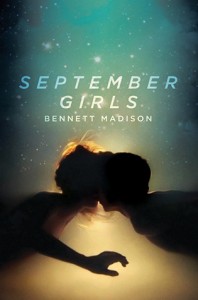
For what it’s worth, the overall breakdown here is: 4 male authors, 7 female authors; 6 fantasy, 5 sf; and
5 female leads to 6 male leads.
The Woken Gods by Gwenda Bond. Fantasy, female lead. I love the premise: “Five years ago, the gods of ancient mythology awoke around the world.” This is the setting for seventeen-year-old Kyra Locke’s adventures in search of her missing father and his secrets.
Homeland by Cory Doctorow. Science fiction, male lead. The sequel to Little Brother, Homeland stands on its own legs, with plenty of action and a lead character, Marcus Yallow, who is beleaguered by questions about releasing information in a plot that seems extraordinarily timely.
Maggot Moon by Sally Gardner Science fiction, male lead. An outstanding voice and unusual premise make the story told by social outcast Standish Treadwell well worth picking up. This was a 2014 Michael L. Printz Honor Book.
When We Wake by Karen Healey Science fiction, female lead. When sixteen-year old-Tegan Oglietti is unexpectedly moved forward a century in time, she finds herself in a future that’s far from benign, and one that will force her to act in order to keep others from sharing her fate.
Summer Prince by Alaya Dawn Johnson Science fiction, female lead. Johnson’s past books have been terrific and this one is no exception. It’s an interesting take of a future society that is fresh and well-written.
September Girls by Bennett Madison Fantasy, male lead. This book is set on North Carolina’s Outer Banks and therefore had me from page one. It’s a beautiful, evocative book that treats mermaids in a poetic and (I would argue) feminist take that is gorgeous and has a fabulous mythic quality.
Far Far Away by Tom McNeal Fantasy, male lead. The narrator is the ghost of one of the Brothers Grimm…and it goes from there. There’s a slight resonance with Neil Gaiman’s American Gods that comes at a jarring moment, but overall, a terrific and interesting novel.
A Corner of White: The Colors of Madeleine, Book One by Jaclyn Moriarty Fantasy, female lead. I don’t even know how to begin to describe this book, except that it is well written and playful in a way that sometimes is not associated with young adult books. Really lovely.
More than This by Patrick Ness Science fiction, male lead. I will admit I don’t usually like books where the protagonist wakes up amnesia, because it’s a situation that’s been done to death. But the place where Seth awakens is odd enough that I reluctantly found myself drawn into his explorations.
Man Made Boy by Jon Skovron Fantasy, male lead. Boy is, in fact, Frankenstein’s monster, and his plight is touching and funny and lovely, particularly when he runs away with the granddaughters of Jekyll/Hyde. This is a funny book in the way funny books should be, and will make your heart hurt even while you’re laughing.
In the Shadow of Blackbirds by Cat Winters Fantasy, female lead. Reviewers aren’t supposed to talk about the book as a physical object, but I still want to note that this is a handsome book with evocative illustrations that really add to the experience. Sixteen-year-old Mary Shelley Black has been sent to San Diego during the Spanish flu epidemic in 1918. When she begins to hear the voice of her recently-killed lover, she becomes involved with the Spiritualist movement. Rich historical details add a lovely texture to the book as well.




 I was on the road for most of September. That photo’s taken in the elevator of the Flatiron Building while I was in NYC, but other places I stayed included Dallas, Texas and Pocatello, Idaho. (More on that to come!) Here’s what I read in September, according to my notes, which always seem to leave out some stuff. Bolded indicates a particularly notable read.
I was on the road for most of September. That photo’s taken in the elevator of the Flatiron Building while I was in NYC, but other places I stayed included Dallas, Texas and Pocatello, Idaho. (More on that to come!) Here’s what I read in September, according to my notes, which always seem to leave out some stuff. Bolded indicates a particularly notable read.
